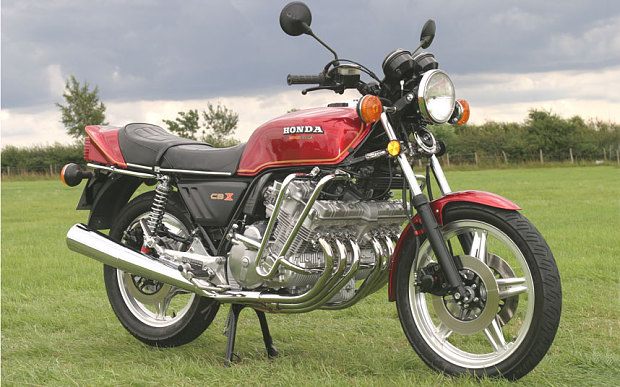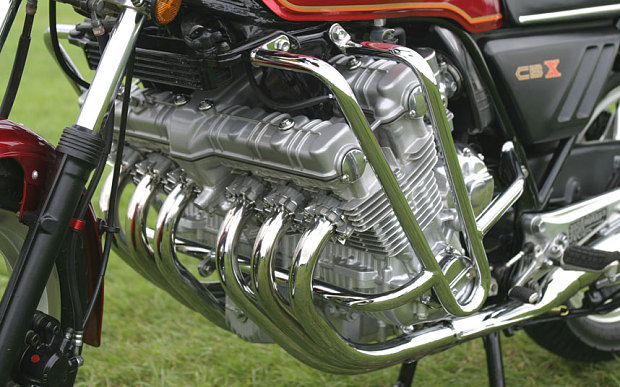Classic bikes: Honda CBX

Photo: CAROL MELLING
No matter how many bikes you have seen, and heard, the Honda CBX 6 still brings a tingle to your spine. Six huge, air-cooled cylinders stretching naked and unashamed across the frame proclaim that this is a motorcycle without compromises. Then there is the noise. The soprano wail from the twin exhausts would stir the soul of an electric bike rider!
When Honda opened its then brand-new R&D centre at Asaka it wanted a statement to the world that here were the best designers who could push the envelope the farthest. However, rather than the youngsters who filled the corridors they turned to Shoichiro Irimajiri, the designer of the six-cylinder bikes raced by Mike Hailwood and Jim Redman.
Irimajiri was clear about the link between the exotic GP machines and the road-going CBX. At the bike’s launch in 1978 he said: “When we were racing, we were up against four-cylinder two-strokes built by Yamaha and Suzuki. Cylinder multiplication was the only way we could be competitive. That’s why we built the five-cylinder 125 and the two [250cc and 350cc] six-cylinder machines.
“The CBX is a direct descendant of these race engines. That’s one reason why it took only a year and a half to develop the bike. We already had the engine technology from our GP racing experience.”
 Honda’s six-cylinder engine was barely wider than that of the four-cylinder CB750 Photo: CAROL MELLING
Honda’s six-cylinder engine was barely wider than that of the four-cylinder CB750 Photo: CAROL MELLING
The CBX was every bit as exotic as its GP predecessors. It featured no less than 24 valves, feeding the motor through the most sophisticated constant velocity carburettors ever made. The engine was also incredibly practical. Despite looking vast, it was only two inches wider than the four-cylinder Honda CB750 it replaced and boasted a sweet gearbox and clutch. Best of all, producing 105bhp at 9,000 rpm, it made the power its looks promised.
The styling was equally iconoclastic. A team of five chassis engineers and stylists, working under the direction of Norimoto Otsuka, produced one of the most dramatic petrol tanks ever to grace a motorcycle. Its shape is both sinuous and voluptuous – as if liquid has been poured over the bike and then frozen in an instant.
The chassis was less successful, with spindly front forks and a swinging arm which was definitely not conceived by a master engineer. Neither were the rear shocks. Finally, the Dunlop tyres, which the bike wore as standard, did not do the bike any favours.
Not that any of these factors caused the CBX to handle badly. Rather it required thought, care and intelligence to perform well.
The root of the problem lay mainly in its weight. Tipping the scales at almost 600 pounds wet, this was not a bike which took kindly to sloppy or indecisive riding. And so developed the great myth that CBXs don’t handle.
This falsehood, combined with a high list price, eventually killed the bike. The gossip was also that Honda actually lost money on every CBX it sold. So, after only four years, CBX production ceased – and the biking fraternity should have mourned the passing of a truly great motorcycle.
Now, equipped with modern tyres and rear shocks, there is nothing in the motorcycling world which can surpass the feeling of wafting effortlessly along on a six-cylinder magic carpet.
THE FACTS
Honda CBX (1978-1982)
TESTED 1,047cc 24-valve, dohc, air-cooled six-cylinder with six carburettors, five-speed gearbox
PRICE NEW/PRICE NOW £2,750/£14,000
POWER/TORQUE 105hp@9,000rpm/63lb ft@8,000rpm
TOP SPEED 130mph
VERDICT Unique, thrilling, versatile and worth every penny of its current high price. Once ridden, never forgotten
TELEGRAPH RATING Five out of five stars
For all the latest news, advice and reviews from Telegraph Cars, sign up to our weekly newsletter by entering your email here
Source: www.telegraph.co.uk
